Obesity in the United States is a problem. Over 40 percent of adult Americans are obese, according to Trust for America’s Health and “1 in 5 children and adolescents in the US have obesity”, the Centers for Disease Control and Prevention states. There are several causes for obesity like genetics and lifestyle choices and being grossly overweight can be linked to significant health issues such as high blood pressure (hypertension), high LDL cholesterol, low HDL cholesterol, or high levels of triglycerides (Dyslipidemia, Type 2 diabetes, coronary heart disease, stroke, gallbladder disease and death). But the good news is with hard work and positive behavior changes weight can be lost. Eat This, Not That! Health talked to several health experts who revealed how to reverse obesity and help keep the excess pounds off.
Read on—and to ensure your health and the health of others, don’t miss these Sure Signs You’ve Already Had COVID.
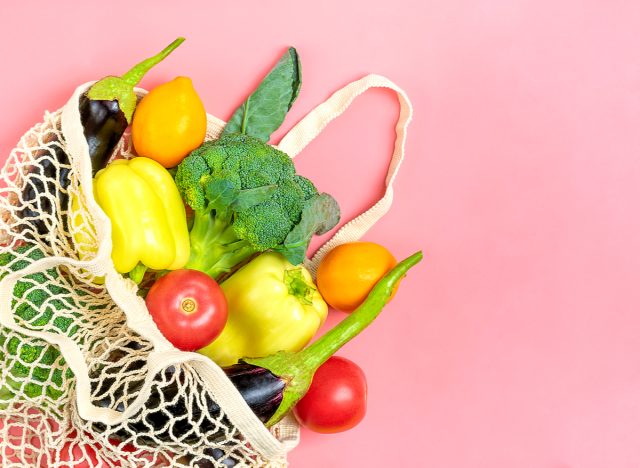

Amy Davis, RD, LDN explains, “A plant-based diet has the power to cure obesity for many reasons. First off, fruits and vegetables are the main foods eaten, and they are very low in calories while being very high in nutrients such as fiber and antioxidants. Also, replacing processed foods with plant-based foods will often inadvertently decrease calorie consumption and mindless snacking.”
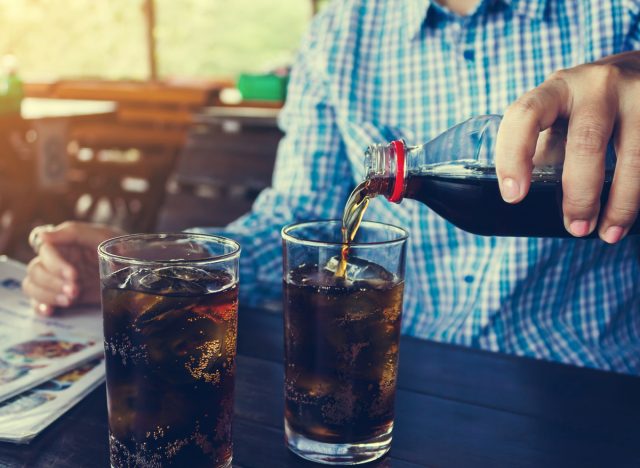

“Replace drinks with water – Sodas, sports drinks, and even sweetened coffees are some of the biggest drivers of sugar consumption in the United States,” Daivs states. “Replacing these drinks with water will drastically decrease calorie and sugar intake, saving folks thousands of calories and grams of sugar over weeks and months.”
RELATED: Sure Signs You May Already Have Alzheimer’s


According to Davis, you should squeeze in a workout at the start of your day. “Exercise first thing in the morning – Even just 20 minutes of exercise first thing in the morning has massive benefits that can help reverse obesity. A morning workout will increase levels of dopamine and serotonin, jumpstart the metabolism, while decreasing cortisol. These neurological benefits trickle into the rest of someone’s day, helping them feel better, make better food choices, and overall improve the quality of life.”
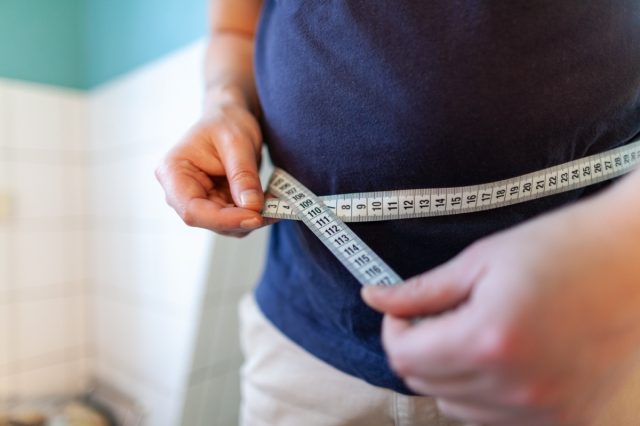

Dave Shelton, Founder & Trainer at My Fitness System says, “Do not target losing 10 pounds per week and having the world’s most strict diet. This sounds great, but is not feasible. It is better to set your goals small at first so that you can achieve them. Small feats of success will motivate you to keep pushing in your fight against obesity.”
RELATED: Surefire Ways to Shrink Abdominal Fat


Steven M. Sultanoff, Ph.D. Clinical Psychologist Professor Pepperdine University says, “Start a high-quality sugar diet. What is that you wonder?? It is an eating style where you do not restrict anything but before eating that coveted sweet or large quantity you pause and ask, ‘Is this how I want to invest my sweet desires? Do I want to skip this candy bar so that I later have my chocolate cake?’
You may see what is really happening with this ‘diet.’ You are slowing down your food choices and delaying gratification. The more you delay, the fewer calories you ingest, and you are on your way to managing eating which of course manages weight.
You are making yourself conscious of food choices. This may also include looking at the calorie count on a restaurant menu and then making a choice of how to invest calories. Of course, there are weight loss programs that set number limits on calories, but as you know, for the most part, these are not successful. This ‘diet’ is really a cognitive lifestyle change keeping the individual in control while at the same time not burdening the individual with limits and structures that are so often resisted. Over time it becomes integrated into the fabric of one’s being.”


Stephanie Lincoln a Licensed Mental Health Counselor and Nutrition Coach reveals, “The only way that our modern society will be able to reverse obesity is by tackling the 10,000-pound elephant in the room, food addiction. We are a society of food addicts. It is the most prevalent addiction, yet, no one is talking about it. Because of our evolutionary biology, our brains and bodies were designed to give us very strong, almost impossible to ignore, impulses to overeat and to crave the things that will fatten us up the quickest, sugar and carbs. Our biology was designed that way because it helped our ancestors survive. Our ancestors had to overeat when they could because the occasion didn’t come up too often. It helped us store fat and be ready for the many times a year where we went hungry, due to lack of access to food because of the season, migration, or famine. Unfortunately, those compelling hormones that urge us to eat ample calories to fatten up still exist in our modern biology. We are addicted to food and unless we address this in ourselves, we will never be able to overcome obesity.”
RELATED: Warning Signs You Have a “Fatty Liver”
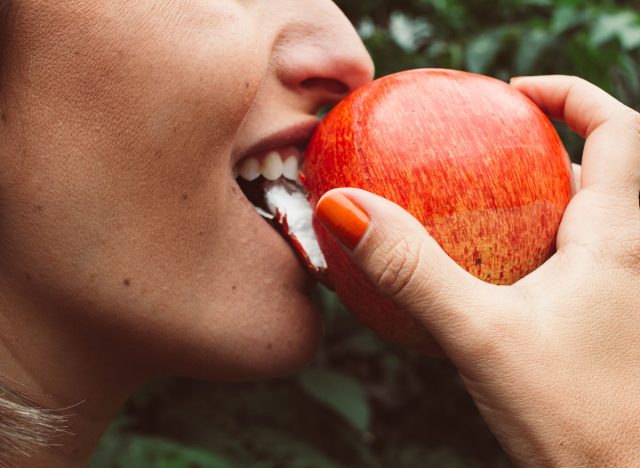

“The best way to optimize our biology through nutrition is to eat like our ancestors,” Lincoln says, “Our biology developed this way for a reason and it helped us survive for thousands of years as a species, why not work with our biology instead of against it? Think of a typical day in our ancestors’ lives. Did they get out of bed and immediately consume 2 cups of coffee with maple sugar and a big bowl of sugary cereal? NO! They got up and started work. They went foraging or hunting. They prepared for the migration of the day. They didn’t snack or drink all day. They worked, they hunted, they foraged, then they brought it all back to the community, prepared the food, and enjoyed it that evening. They may have brought along a water skin, or some dried meats as a snack to have during the day, but the largest meal of the day was always at day’s end, and there was always ample time in between meals. Not to mention their foods did not have ingredients like monosodium glutamate, Blue 1, Red 40, Yellow 5 and Yellow 6, and high-fructose corn syrup. Has anyone wondered about the correlation between sharply increasing numbers of obesity, cancer, heart disease, stroke, and diabetes, with the explosion of processed food availability in the U.S? Your food should have one ingredient. Chicken has chicken. Eggs have eggs. An apple has an apple. Eat real food and eat one large meal a day with small, high-protein snacks during the day to sustain energy.”


According to Morton Tavel, MD., Clinical Professor Emeritus of Medicine, Indiana University School of Medicine, “Hunger is complex, and we eat for many reasons besides biological hunger. It’s important to try to distinguish between ‘stomach hunger’ and “mind hunger,” though they usually merge together. While some psychological factors (such as eating when we are sad or stressed, or in social gatherings) can sabotage our efforts to make healthy choices or eat fewer calories.If you have a variety of high calorie processed junk foods around you’re more likely to be tempted by them. Since the same rule applies to fruits, vegetables, and lean proteins, the more of these healthy foods you have on hand the better. Naturally high fiber foods—like fruits, vegetables, whole grains, legumes, nuts, and seeds—are one of the keys to controlling hunger. Putting food on a smaller plate is another useful trick: the same amount of food is more satisfying when eaten from a full small plate than a half-empty large plate.”
RELATED: How to Reverse Dementia Risk, According to Experts


Tavel says, “Eating slowly and not skipping meals are also helpful behavioral strategies.It takes about 20 minutes for gut satiety hormones to increase after a meal, so that if we eat quickly, we may not give our bodies time to tell us we are full. Slowing down the pace of eating might therefore help with weight loss.”
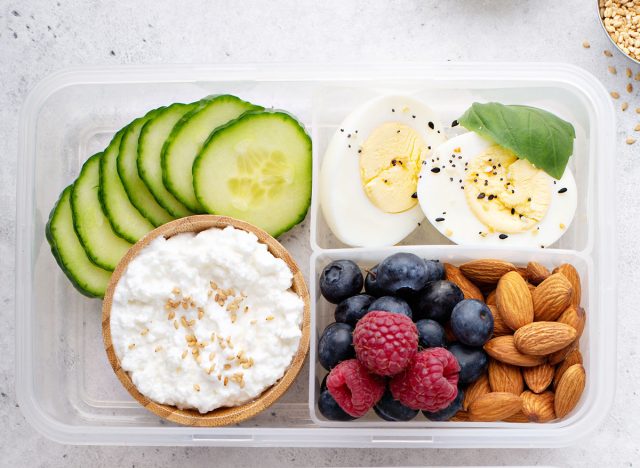

“Include a protein source with each meal—and aim to spread it out fairly evenly throughout the day,” Tavel states. “The typical American diet is heavy on protein at dinner, and light at breakfast. I would suggest including Greek yogurt, cottage cheese, eggs, and nut butter or nuts as quick and easy ways to increase protein in the morning meal. Adding plenty of fiber to protein serves as good appetite suppressants. Fiber. Minimally processed, higher fiber foods may help keep hunger at bay.
Consuming foods naturally high in fiber, such as whole grains, fruits, and vegetables, which seem to stimulateGLP-1 from the gut, which can inhibit appetite in the brain. Different food sources of fiber may promote different degrees of satisfaction. Soluble fiber helps especially to increase feelings of fullness/satiety, packing the stomach to impart a sensation of fullness. It also slows the movement of food through the intestinal tract, which also helps us feel satisfied. All fruits, vegetables, whole grains, and legumes contain some soluble fiber, but beans, oats, barley, citrus fruits, and apples are some top sources. Choosing whole grains or minimally processed whole grain foods, such as steel cut oats or breads made with larger pieces of grain, may help you feel more satisfied compared to eating the same amount of a fine grain. This is because some whole grains are coarser and take longer to digest. Whole grains, such as oatmeal and barley, also blunt spikes in blood sugar, which helps to control hunger.
Another benefit to naturally high-fiber foods is that they take longer to chew and therefore slow down our eating. It’s much easier to wolf down a bag of chips or a breadstick or gulp a sugar-sweetened beverage than work through an apple, carrot sticks, a salad, or a bowl of whole grain, bran-based cereal.”
RELATED: Surefire Ways to Stop Obesity, Says Science


Dr. Sepehr Lalezari, MD., a Bariatric Surgeon in Los Angeles with Dignity Health St. Mary says, “Obesity is very strongly associated with Type 2 diabetes mellitus where >80 percent of cases of type 2 diabetes can be attributed to obesity.
Weight loss is associated with a decreased risk of type 2 diabetes, improvement in blood glucose control and possible resolution of the disease.
Obesity and increased fat in the abdominal region are strongly associated with various medical diseases such as diabetes mellitus, hypertension, heart disease, stroke, sleep apnea, and many other chronic and debilitating diseases. Even 10% weight loss improves these obesity related medical conditions! Weight loss has such a dramatic effect on patients. Speaking of my own experiences with my patients, it often brings me to tears as they come back to my office to follow up and tell me how much their lives have changed as a result of weight loss.
A few of my patients are now on the kidney transplant list because they were able to lose their excess weight and quality for transplant.
Many of my patients have resolved their diabetes, hypertension, sleep apnea and now are able to play with their children without getting tired or short of breath. Lives are completely altered because they have more confidence and energy to face the world and all its hurdles. I am so proud of my patients and what they have accomplished, it’s not easy, weight loss is not easy, nor is surgery. There is no magic bullet, it takes hard work and determination. The best part of my day is seeing my patients walk into my office taller than they were before and with a tangible aura of happiness for accomplishing something they only ever dreamed of doing on their own. Weight loss is a journey and my patients and I “journey strong” together through the process.
Their social lives have improved and they are more happy and involved in their communities. With weight loss, what patients view as an impossible obstacle can be achieved with the right help. Many patients don’t realize what help is available and that it is often fully covered by their insurance. Only about 2-3% of people who qualify for bariatric surgery ever undergo the procedure. Some of this is due to mis-information and social stigma. It is important to realize and educate the public that obesity IS A DISEASE and there is treatment for it! To get the help you need to talk to a bariatric specialist surgeon or medical doctor to see what your options are. There’s everything from diet and exercise plans, medications, incisionless procedures, to surgery. Of course the effectiveness of these vary but there are so many options out there and people just don’t know that there is help. They feel as though they have tried and failed so they give up and think it can’t be done. I follow my patients very closely and have them lose weight with a special supervised diet plan sometimes this includes medications sometimes not. It’s always catered to my patients specific needs and goals and that is what a weight loss specialist can do for you as well. As a weight loss specialist and bariatric surgeon I am able to offer my patients the full gamut of support.” And to get through this pandemic at your healthiest, don’t miss these 35 Places You’re Most Likely to Catch COVID.